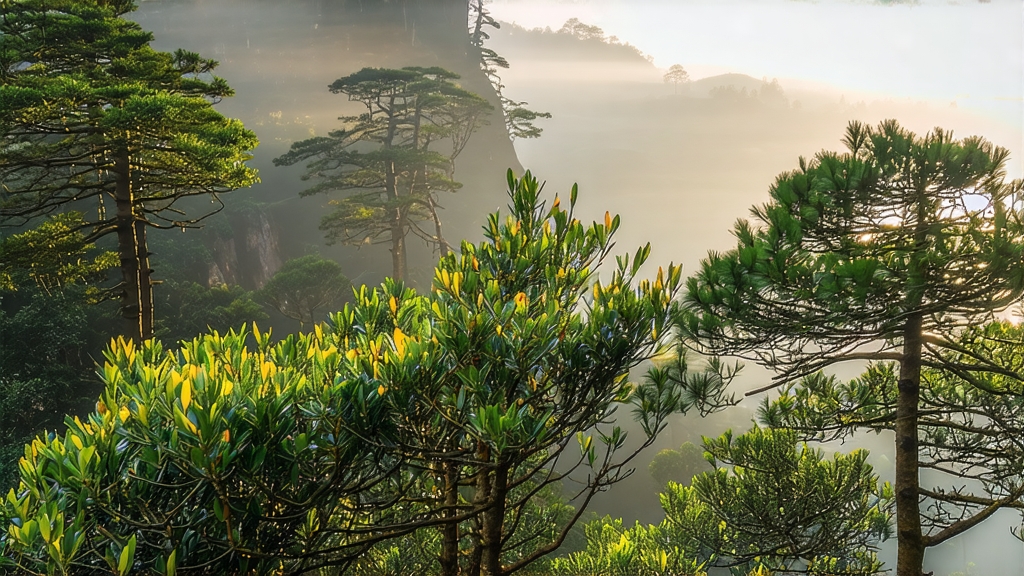
High on Mengding Mountain, where Sichuan’s mist coils around 1,500-year-old tea trees, a tiny yellow bud has been whispering its story since the Tang dynasty. International drinkers may speak reverently of Longjing or Da Hong Pao, yet few have tasted Mengding Huangya, the “Imperial Yellow Bud” that once traveled in bamboo tubes lined with silk to the courts of emperors. This essay invites you to meet the tea that history misplaced: a yellow tea so subtle that even seasoned tasters confuse it with green, so rare that only a few hundred kilograms leave the mountain each spring.
-
A bud born of poetry and politics
Mengding Shan, “the misty peak that brushes heaven,” was already famous when the poet Bai Juyi wrote of “snowy buds plucked before the Qingming rain.” In 724 CE the Tang emperor Xuanzong decreed the mountain’s first 360 mu of tea garden sacred; by 1107 CE the Song court had sealed the picking ritual behind palace walls. Yellow tea as a processing style, however, did not appear until the Ming, when a slow “sealed yellowing” step was added to prevent the grassy bite of green tea during the long caravan ride to Beijing. The buds that left Mengding wrapped in golden foil thus acquired a pale champagne hue and a nectar-like softness, earning the name Huangya—“yellow sprout.” When the Qing dynasty fell in 1911, imperial tributes ceased, and Mengding Huangya retreated into local monasteries, preserved only by monks who bartered it for salt and incense. -
Micro-terroir in the clouds
The garden zone sits between 800 m and 1,400 m on a shoulder of the Tibetan Plateau. Night temperatures drop 10 °C within hours, forcing the tea bush to hoard amino acids; morning fog filters ultraviolet light, thickening the leaf’s soluble sugars. The soil is a crumbly quartz-rich loam, so acidic (pH 4.3) that even rhododendrons grow stunted. Only two cultivars survive here: the indigenous “Mengding Xiao-ye-zhong” (small-leaf ancestor) and a purple-veined variant called “Zi Huangya” whose anthocyanins add a faint blueberry note. Because the mountain is a UNESCO heritage buffer zone, pesticides are banned; instead, farmers plant aromatic mugwort and ginger between rows to confuse leaf-eating insects. -
The slow art of sealed yellowing
Unlike green tea, which is quickly pan-fired to lock in verdant chlorophyll, Mengding Huangya is coaxed into a gentle oxidation limbo. Picking begins when each bud still wears a fish-scale of down and arches like a shrimp. The pluck—one bud plus the unopened first leaf—must weigh no more than 0.3 g. After a 4-hour wither on bamboo trays, the buds are wok-tumbled for exactly 90 seconds at 160 °C; this “killing-green” step destroys the grassy enzymes but leaves 15 % residual moisture. The critical innovation follows: while the leaf is still warm, it is wrapped in thick yellow cotton paper and buried inside a lacquered wooden chest. Every 40 minutes the chest is opened, the paper unfolded, and the tea gently fanned. Over 48–72 hours the leaf edges suffuse with straw-gold while the center remains jade; polyphenols oxidize just enough to shed astringency, while a new aroma molecule, 3-hexenyl benzoate, emerges, lending warm hay and honey notes. A final low-temperature bake at 55 °C for three hours fixes the color and lowers moisture to 5 %, rendering the bud shelf-stable for decades. -
Grades and guises
Ming-qian Huangya: picked before the Qingming festival, 100 % single buds, delivers a clear liquor the color of chardonnay.
Yu-qian Huangya: picked before the Grain Rain, one bud and one leaf, tastes like white peach with a mineral tail.
Cun-xiang Huangya: “village fragrance,” a larger leaf grade yellowed for only 24 hours, brewed by locals in enamel mugs.
Each grade is further classified by bud curvature: “Sword Bud” (straight), “Spiral Bud” (one twist), and “Dragon Bud” (two twists), a nod to the courtly obsession with mythical